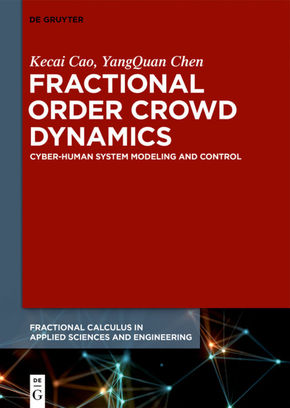
Fractional Order Crowd Dynamics - Cyber-Human System Modeling and Control
| Verlag | De Gruyter |
| Auflage | 2018 |
| Seiten | 125 |
| Format | 17,0 x 1,3 x 24,0 cm |
| Gewicht | 386 g |
| Artikeltyp | Englisches Buch |
| Reihe | Fractional Calculus in Applied Sciences and Engineering 4 |
| ISBN-10 | 3110472813 |
| EAN | 9783110472813 |
| Bestell-Nr | 11047281A |
This book illustrates the application of fractional calculus in crowd dynamics via modeling and control groups of pedestrians. Decision-making processes, conservation laws of mass/momentum, and micro-macro models are employed to describe system dynamics while cooperative movements in micro scale, and fractional diffusion in macro scale are studied to control the group of pedestrians. Obtained work is included in the Intelligent Evacuation Systems that is used for modeling and to control crowds of pedestrians. With practical issues considered, this book is of interests to mathematicians, physicists, and engineers.
Inhaltsverzeichnis:
Table of Content:
Chapter 1 Fractional Model of Microscopic Pedestrians Based on Fractional Decision Making Process
1.1 Introduction
1.2 Fractional Decision Making Process
1.3 Fractional Microscopic Model
1.4 Simulation Results
1.5 Conclusion
Chapter 2 Fractional Model of Macroscopic Crowds Based on Fractional Conservation Law
2.1 Introduction
2.2 Fractional Conservation law of Mass/Momentum
2.3 Fractional Macroscopic Model
2.4 Simulation Results
2.5 Conclusion
Chapter 3 Fractional Model for Micro-Macro Crowds with Presence of Individual of Disabilities
3.1 Introduction
3.2 Fractional Potential Field and IwDs
3.3 Fractional Mean Field Theory
3.4 Fractional Micro-Macro Model
3.5 Simulation Results
3.6 Conclusion
Chapter 4 Cooperative Control of Microscopic Pedestrians with Long Range Interactions
4.1 Introduction
4.2 Relationship between Long Range Interactions and Fractional Calculus
4.3 Relationship between Long Range Interactions and Macroscopic Movement
4.4 Cooperative Control of Microscopic Pedestrians with Long Range Interactions
4.5 Simulation Results
4.6 Conclusion
Chapter 5 Boundary Evacuation Control of Macroscopic Crowds of Pedestrians
5.1 Introduction
5.2 Fractional Reaction-advection-diffusion Model
5.3 Boundary Conditions for Desired Evacuation
5.4 Evacuating Controllers for Boundary Robots
5.5 Wave-absorbing Re-design of Boundary Evacuating Controllers
5.6 Simulation Results
5.7 Conclusion
Chapter 6 Intelligent Evacuation Control of Large Crowds of Pedestrians Using FODIFF-MAS
6.1 Introduction
6.2 Platform of DIFF-MAS and FODIFF-MAS
6.3 Simulation Results of Large Crowds on Micro, Macro and Mesco Scale
6.4 Simulation Results of Large Crowds with Long Range Interactions
6.5 Intelligent Evacuation Control of Large Crowds
6.6 Conclusion
